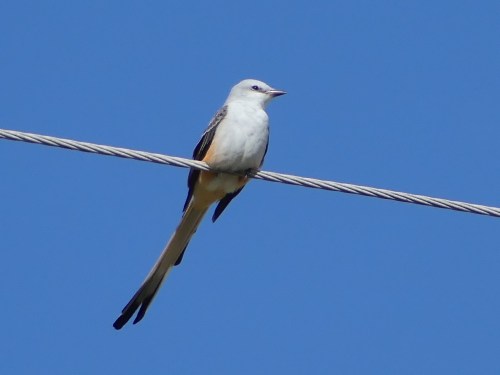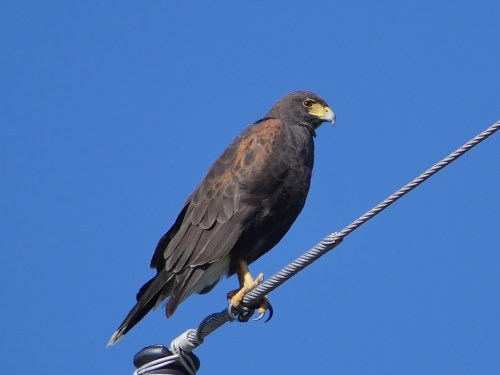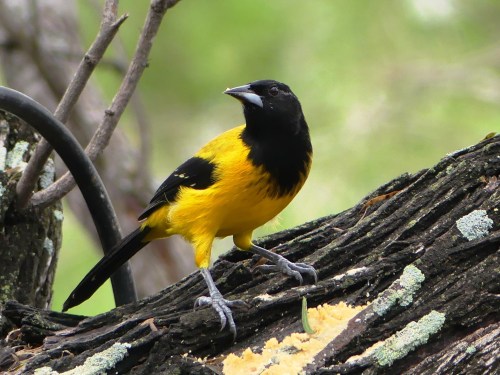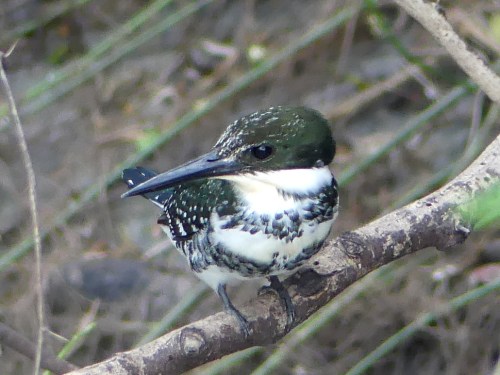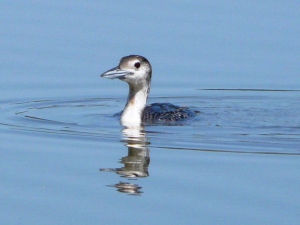After our wonderful adventures in Panama, Diane and I wanted to do another birding trip this year. Another international trip was not possible, so we decided that the Rio Grande Valley Birding Festival in November in Texas would be perfect. Diane would be able to see her first Green Jay and other amazing birds of South Texas. I would be sure to get photos of new species and maybe even a few lifers if I were lucky.
I drove to Texas in three days and got into Harlingen a full day before the festival began. I was greeted by thousands of Great-tailed Grackles on the power lines by the hotel. Although very common birds, the spectacle of the grackles and starlings loudly screeching and their intermittent murmurations as they flew and then resettled on the wires was exhilarating.
I started my first full day in South Texas at Estero Llano Grande State Park, which turned out to be one of my favorite locations in the valley. The pond in front of the Visitor Center draws many species of ducks, all very close. But, this park may be best known as an almost guaranteed place to see Common Pauraque. Park rangers share the daytime roosting locations with visitors; otherwise, it would be nearly impossible to find this bird nestled in the leaves.

Common Pauraque are nocturnal birds that roost in leaves and brush piles during the day. Their highly effective camouflage makes them difficult to find.
It was a wonderful morning with Green Kingfishers, White-tailed Kites, and many more. But, it was hot! By noon, I was about to drop from the heat. I met another birder who was also interested in looking for Mountain Plovers, seen in the past just north of Harlingen. We joined forces and spent the afternoon in his air-conditioned car searching the fallow farm fields without success, but we did see raptors and other birds including a gorgeous Scissor-tailed Flycatcher.
Diane arrived on Tuesday evening and we went to bed early for our 4:15 AM wake-up on Wednesday. Our first festival field trip was to Las Estrellas Preserve, a 415-acre Nature Conservancy property that was purchased to protect the federally endangered star cactus, a spineless succulent with yellow flowers which is known to grow only in Starr County, Texas, and a few places in Mexico. Because the cactus is vulnerable to poachers, the property is not open to the public.

Star cactus shrinks to the ground when stressed. It was not in bloom when we visited and it was difficult to find.
Next it was on Rancho Lomitas for lunch and a visit with Benito Trevino, owner of the ranch and the leading ethnobotanist in South Texas. We were all fascinated by Benito’s knowledge of the history and uses of native plants. Plants were the focus of this locale, but we had hoped to also see Audubon’s Oriole here. Our guide did catch a glimpse of one, but the rest of us missed it. However, we were very happy with good looks at Scaled Quail, a Greater Roadrunner, many other birds, and Benito’s fascinating stories about plants.

A Greater Roadrunner played hide and seek in the courtyard, mostly hiding in the vegetation. Here he dashes across an open area.
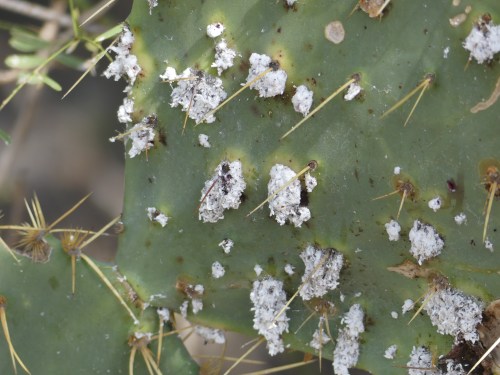
Cochineal, an insect, growing on prickly pear cactus. We learned how the Indians used cochineal to make red dye.
For day two of the festival, Diane and I had chosen the Upper Rio Grande trip with visits to Roma Bluffs, Chapeño, and Salineño. There are famous feeders at Salineño, where we hoped for another chance to see Audubon’s Oriole, but we missed it again. It was fun to meet Noah Strycker (one of our guides for the day) and we loved sitting at the Salineño feeders watching the Golden-fronted and Ladder-backed Woodpeckers, Plain Chachalacas, Green Jays, Orange-crowned Warblers, and all the other birds that come for suet, seed, and nectar.
We got back to Harlingen in time for our late afternoon Parrot Trip. We could have found the parrots by ourselves, but quickly decided that this was $40 well-spent just for the fun of being driven around town madly searching for parrots. We were in one of three vans, all communicating by walkie-talkie. It was an efficient and fun way to quickly find the target birds. First, we saw Green Parakeets, which I had seen on my trip in April 2011. And, then one of the vans found the Red-crowned Parrots. Finally – my first life bird at the festival. Nothing is more fun than watching parrots with their loud, affectionate, and comical behavior.

Red-crowned Parrots in Harlingen. We learned that they not only mate for life; pairs are together constantly and can even be distinguished in a flock by their close proximity to each other even in flight.
The third festival day, Diane and I did different trips. I opted for Southmost Preserve, another Nature Conservancy property not normally open to the public. Both Tropical and Couch’s Kingbird are common in the valley, but they are nearly impossible to differentiate unless heard vocalizing. On this trip, we had several individuals of both species. And, we heard one Couch’s Kingbird not just calling, but singing his full song. It was also interesting to see the kingbirds catching and eating Monarch butterflies.
It was a great morning with many species ranging from ever-popular White-tailed Kites to a rather rare Warbling Vireo.
Friday evening was a festival highlight – Noah Strycker’s keynote address about his Global Big Year. Off-stage, Noah is a very nice person, quiet and unassuming. On-stage, he morphs into an animated and dynamic speaker. The audience was totally awed by his fascinating stories. Noah impressed me, not just with his spirit of adventure, physical fortitude, and calmness in challenging situations, but also with his kindness, humility and obvious love for the birds and people of the entire planet.
On Saturday, Diane and I did different trips again. She choose the Laguna Atascosa National Wildlife Refuge tour which included parts of the refuge not normally open to the public, where they saw a much sought-after Texas bird, Aplomado Falcon. I choose Nathan Pieplow’s “Bird Sounds Decoded” field workshop. We had a small group and it was really fun to get an introduction to Nathan’s method of identifying birds by ear, a method that does not require memorization. I bought Nathan’s book Peterson Field Guide to Bird Sounds and can’t wait to study it and improve my ear birding skills.
Our leaders were always alert to interesting flora and fauna. On this morning, Nathan discovered a Red-bordered Pixie, a beautiful butterfly never found north of the Rio Grande Valley.
It seems that a rare bird shows up in South Texas during the festival every year. This year, a couple of Tamaulipas Crow were discovered at South Padre Island a day or so before the festival started. These birds were formerly reliably found at the Brownsville Landfill, but none had been seen anywhere in Texas since 2010. A couple of days after the first sighting, the birds were at the Brownsville dump again and birders were flocking there to add Tamaulipas Crow to their life lists. I was no different. I hitched a ride with Nathan after his workshop and we had great looks at the crow. Life bird #2 for the trip!
Sunday, November 12, was the last day of the festival and Diane and I were scheduled for what we expected to be the most exciting field trip of the week – King Ranch. The target bird was Ferruginous Pygmy-Owl, which was almost guaranteed to be seen. It had never been missed during previous festivals. But, this year was different. The temperature had fallen quickly and dramatically to 20 or more degrees lower than normal. Ferruginous Pygmy-Owl is a tropical owl, just reaching its northern most range in South Texas. It had not been seen all week, presumably due to the cold weather. On Sunday, it had warmed up again, almost to normal, so we were hopeful. But, it was not to be. One of the King Ranch guides heard one in the distance, but none of the festival participants heard or saw the little owl.
We were also told that we would have another chance to see Audubon’s Oriole at King Ranch, but we missed it, too. Missing the owl and oriole were big disappointments, but there was one consolation. Near the end of the morning, we were looking for Sprague’s Pipits when a guide screamed “Zone-tailed Hawk!” It was not the close look that I wanted, but I did see the bird and even got a poor photo showing the “zone” tail. Life bird #3 of the trip.
Diane and I had scheduled three days to bird on our own after the festival and we knew the first place that we would head on Monday morning – the feeding station at Salineño.
The Audubon’s Orioles had been seen just before our arrival. We sat there for three hours waiting for them to return, but we enjoyed the other avian activity at the feeders. Finally, my most-wanted bird showed up – first a male Audubon’s Oriole and then his mate, both close enough to get great looks and photographs. Life bird #4 and I was thrilled.
We stopped at Estero Llano Grande on our way back to Harlingen. We didn’t have much time, but wanted to get a look at a Common Pauraque for Diane. The park was magical, so much cooler than when I had been there a week earlier and we almost had the park to ourselves. We found the Pauraque right away, and the nearby Eastern Screech-Owl, who seemed to sit looking out of its nest box all day every day.

“McCall’s” Eastern Screech-Owl ranges from south-central Texas to parts of northern Mexico. It may prove to be a separate species, as it is always gray and never gives the “whinny” call.
As we left that area and walked by a pond, Diane heard what she was sure was a kingfisher. She tracked down this beautiful female Green Kingfisher in the ditch across the path from the pond. We had both seen this species before, most recently in Panama, but it was a treat to be so close and see it so clearly.
We spent much of our last two days looking for Aplomado Falcon, to no avail. We had both seen it previously, but we were hoping for a better look. We also went to Estero Llano Grande State Park one more time and again enjoyed the wonderful birds there.
As usual, our time was up too quickly. Diane flew home and I started the drive back to North Carolina, stopping the first night at the home of a new friend we met at the festival. Birders have to be the friendliest people on earth and making new friends is as good as seeing new birds. It was a wonderful trip and I can’t wait to go back again.
More photos from this trip can be viewed in my Flickr album, RGV Texas – Nov 2017.

